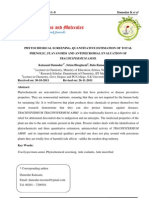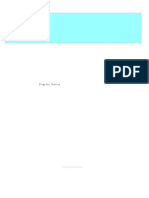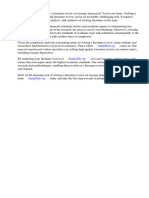Materials and Methods Collection of Medicinal Plants
Materials and Methods Collection of Medicinal Plants
Uploaded by
sumiCopyright:
Available Formats
Materials and Methods Collection of Medicinal Plants
Materials and Methods Collection of Medicinal Plants
Uploaded by
sumiOriginal Description:
Original Title
Copyright
Available Formats
Share this document
Did you find this document useful?
Is this content inappropriate?
Copyright:
Available Formats
Materials and Methods Collection of Medicinal Plants
Materials and Methods Collection of Medicinal Plants
Uploaded by
sumiCopyright:
Available Formats
MATERIALS AND METHODS
COLLECTION OF MEDICINAL PLANTS :-
Fresh and healthy plants were collected for over three months time (Oct-
Dec 2017) from various locations of the kanyakumari District (Attoor) of these
plants two medicinal plants were selected for the study.
Andrographics paniculata, Nees.
Division - Magnoliophyta
Class - Magnoliopsida
Sub Class - Dilleniidae
Order - Capparales
Family - Moringaceae
Genus - Moringa
Species - oleifera
Moringa oleifera is the most widely cultivated species of a monogeneric
family, the Moringaceae, which is native to the Sub – Himalayan tracts of India,
Pakistan, Bangladesh and Afghanistan. India is the largest producer of Moringa
with an animal production of 1.1 to 1.3 million tones of tender fruits from an area
of 380 Km2.
Moringa oleifera is a short, slender, deoduous, perennial tree to about 10m
tall rather slender with drooping branches corhy bark, leaves fieathery, pale green,
compound, tripinnate 30, 60cm long with many small leaflets. Flowers fragrant,
white or creamy, stamens yellow pods pendulous, main root thick.
PREPARATION OF EXTRACT
Freshly collected plant leaves were shade dried for ten days and grind. The
grind powder was soaked in 10ml of different solvents such as ethanol, n-butyl
alcohol, iso - propyl alcohol, benzene and acetone. All the solvent extracts were
kept at room temperature for 10 days with periodic shacking to extract the
compounds from the powdered material. The extracts were obtained by passing
through the muslin cloth, the respective solvents were evaporated with the help of
heating mantle. Then it was stored in air tight bottles for further study.
PREVENTION OF NATURAL DISC
Sterile discs were obtained and stored at 4°C. Discs were handled using a
pair of presterilized forceps. The extract was loaded on to the disc carefully using
capillary tube, without spreading out. Thus the disc completely saturated with the
extract was used for testing antibacterial activity.
SYNTHETIC DISC
The synthetic discs used were chloramphenicol, Kanamycin and neomycin.
HUMAN PATHOGENIC USED
A total of five human pathogens were used in the study staphylococcus
aurous, Escherichia coli, proteus vulgaris, pseudomonas aeruginosa and salmonella
typhi. All human pathogens were purchased from the (Scudder laboratory,
Nagercoil)
CULTURE OF TEST HUMAN PATHOGENS (DILUTION)
An inoculums of each pathogen was suspended in 3m1 of nutrient broth. The
bacteria species were cultured in the nutrient broth. All culture were incubated at
37°C for l8hr and then diluted to 1/10 the concentration to yield a culture density
of approximately 108 CFU/ML.
You might also like
- 10 Herbal Plants Approved by DOHDocument66 pages10 Herbal Plants Approved by DOHAsthra R.100% (1)
- Pharmacognostical and Phytochemical Studies Of: Annona Reticulata LinnDocument6 pagesPharmacognostical and Phytochemical Studies Of: Annona Reticulata LinnAfsal KunnummalNo ratings yet
- A A A A C CC C A A A A D D D D Eeee M M M M IIII C CC C S S S S C CC C IIII Eeee N N N N C CC C Eeee S S S SDocument3 pagesA A A A C CC C A A A A D D D D Eeee M M M M IIII C CC C S S S S C CC C IIII Eeee N N N N C CC C Eeee S S S Smakerk82No ratings yet
- Effective Method for In-vitro Micropropagation of Solanum xanthocarpum Schard and Wendl from Seeds and Inter-nodal Explants (Subtitle: Invitro Micropropagation of Solanum xanthocarpum Schard and Wendl )Document6 pagesEffective Method for In-vitro Micropropagation of Solanum xanthocarpum Schard and Wendl from Seeds and Inter-nodal Explants (Subtitle: Invitro Micropropagation of Solanum xanthocarpum Schard and Wendl )International Journal of Innovative Science and Research TechnologyNo ratings yet
- Al Jadidi2016Document4 pagesAl Jadidi2016Leandro DouglasNo ratings yet
- Antimicrobial Activity of Flowers of Ixora Pavetta AndrDocument3 pagesAntimicrobial Activity of Flowers of Ixora Pavetta AndrxiuhtlaltzinNo ratings yet
- Traditional Medicinal Knowledge On Moringa Concanensis Nimmo of Perambalur District, TamilnaduDocument4 pagesTraditional Medicinal Knowledge On Moringa Concanensis Nimmo of Perambalur District, TamilnaduChintamani VeerrajuNo ratings yet
- Analgesic Activity of Extracts of Kyllinga Monocephala: Authors: Amor, Evangeline C. Quanico, Jusal P. SourceDocument15 pagesAnalgesic Activity of Extracts of Kyllinga Monocephala: Authors: Amor, Evangeline C. Quanico, Jusal P. SourcedrisyadivakaranNo ratings yet
- Indigofera Tinctoria Linn - A Phytopharmacological ReviewDocument6 pagesIndigofera Tinctoria Linn - A Phytopharmacological ReviewJessierei Pring PellasNo ratings yet
- 1 s2.0 S1658365513000423 MainDocument8 pages1 s2.0 S1658365513000423 Mainمروة فؤاد حسن شعبانNo ratings yet
- RootsDocument6 pagesRootssomen mojumderNo ratings yet
- Pola Aliran Bahan Pada Proses PembekuanDocument6 pagesPola Aliran Bahan Pada Proses PembekuanCanggihBlytheNo ratings yet
- Antioxidant Activity of Binahong (Anredera Cordifolia (Tenore) Steen) Simplicia LeavesDocument7 pagesAntioxidant Activity of Binahong (Anredera Cordifolia (Tenore) Steen) Simplicia LeavesArumm88No ratings yet
- Analgetik Dan Antiinflamasi INGGRISDocument8 pagesAnalgetik Dan Antiinflamasi INGGRISArdina Mariana PakpahanNo ratings yet
- Anti Pyre Tic Property of GumamelaDocument6 pagesAnti Pyre Tic Property of GumamelaPipay AkinNo ratings yet
- Randia SpinosaDocument5 pagesRandia SpinosaamritaryaaligarghNo ratings yet
- CichoriumIntybus ReviewDocument5 pagesCichoriumIntybus ReviewSrisriNo ratings yet
- In Vitro Plant Production Through Apical Meristem: Culture of Gentiana Kurroo RoyleDocument6 pagesIn Vitro Plant Production Through Apical Meristem: Culture of Gentiana Kurroo RoyleSandy PrasetyøNo ratings yet
- Jurnal Tentang Jamur InternasionalDocument5 pagesJurnal Tentang Jamur InternasionalCut Kandy SafieraNo ratings yet
- Phytochemical Screening of Solanum Nigrum L,: S. Myriacanthus Dunal, Solanum Melongena and Averrhoa Bilimbi in BangladeshDocument4 pagesPhytochemical Screening of Solanum Nigrum L,: S. Myriacanthus Dunal, Solanum Melongena and Averrhoa Bilimbi in BangladeshrinjaniNo ratings yet
- Insulin Plant - A Review On Insulin Plant Costus Igneus NakDocument6 pagesInsulin Plant - A Review On Insulin Plant Costus Igneus NakAmabel JameroNo ratings yet
- GR Up: SM Journal of BiologyDocument2 pagesGR Up: SM Journal of BiologypusparumismaNo ratings yet
- Antibacterial Activity of Moringa Oleifera (Lam) Leaves Extracts Against Some Selected BacteriaDocument3 pagesAntibacterial Activity of Moringa Oleifera (Lam) Leaves Extracts Against Some Selected BacteriaExtraordinary MaryNo ratings yet
- Extraction Encapsulation and Development of Functional Food of Some Selected Indian Antiviral HerbsDocument7 pagesExtraction Encapsulation and Development of Functional Food of Some Selected Indian Antiviral HerbsInternational Journal of Innovative Science and Research TechnologyNo ratings yet
- Anticandidal Activity of Several Plants Used by Bentian Tribe in East Kalimantan, IndonesiaDocument7 pagesAnticandidal Activity of Several Plants Used by Bentian Tribe in East Kalimantan, IndonesiaHera RatnaNo ratings yet
- 1-s2.0-S2221169115300198-mainDocument6 pages1-s2.0-S2221169115300198-mainThảo PhươngNo ratings yet
- Phytochemical and Pharmacological Evaluation of The Seeds of Annona Squamosa LinnDocument4 pagesPhytochemical and Pharmacological Evaluation of The Seeds of Annona Squamosa LinnLithin LekkalaNo ratings yet
- Paper 2Document10 pagesPaper 2Chandran MuthiahNo ratings yet
- Pharmacognostic Studies On Root-Bark and Fruit of Morinda Tinctoria RoxbDocument5 pagesPharmacognostic Studies On Root-Bark and Fruit of Morinda Tinctoria RoxbPraveena RamkumarNo ratings yet
- 2817 PDFDocument9 pages2817 PDFCaryl Ann C. SernadillaNo ratings yet
- Screening of Medicinal Plants For Secondary MetabolitesDocument6 pagesScreening of Medicinal Plants For Secondary MetabolitesFira Annisa100% (2)
- A C A D e M I C S C I e N C e SDocument8 pagesA C A D e M I C S C I e N C e Sembri baskaraNo ratings yet
- Pharmacognostic Studies On Stem Bark of Oroxylum IndicumDocument7 pagesPharmacognostic Studies On Stem Bark of Oroxylum IndicumInternational Journal of Innovative Science and Research TechnologyNo ratings yet
- Antihelminthic and Hepato Protechtive Properties of Plant Extract (Pan Curry Papaya Kalmegh) 11052018Document43 pagesAntihelminthic and Hepato Protechtive Properties of Plant Extract (Pan Curry Papaya Kalmegh) 11052018Subhrajyoti BanerjeeNo ratings yet
- Mangiferin 3Document7 pagesMangiferin 3Atrimed F & DNo ratings yet
- A Complete Review On Oxystelma EsculentuDocument4 pagesA Complete Review On Oxystelma EsculentuMuzammil Ahmad QureshiNo ratings yet
- Terminalia Bellerica StudyDocument6 pagesTerminalia Bellerica StudyVaibhav KakdeNo ratings yet
- Write the Morphological identification of any one of the following drugsDocument12 pagesWrite the Morphological identification of any one of the following drugsSk BasirNo ratings yet
- Extraction and Phytochemical Screening oDocument7 pagesExtraction and Phytochemical Screening oTrần Trung TínhNo ratings yet
- Thai Zingiberaceae Species Diversity Andn Their UsesDocument8 pagesThai Zingiberaceae Species Diversity Andn Their UsesSrgio SaibusNo ratings yet
- Calotropis Gigantea: A Review On Its Phytochemical & PharmacologicalDocument8 pagesCalotropis Gigantea: A Review On Its Phytochemical & PharmacologicalAkiho SenomiyaNo ratings yet
- Anchal Yadav (Bryo.)Document11 pagesAnchal Yadav (Bryo.)sp7707403No ratings yet
- Perez Pcog Experiment#1Document4 pagesPerez Pcog Experiment#1Xierylle Kaye PerezNo ratings yet
- Evaluation of The Antimicrobial, Antioxidant and Phytochemical Activities of Methanolic and Aqueous Extract of Cissus Aralioides Leaves On Some Selected Pathogenic MicroorganismsDocument5 pagesEvaluation of The Antimicrobial, Antioxidant and Phytochemical Activities of Methanolic and Aqueous Extract of Cissus Aralioides Leaves On Some Selected Pathogenic MicroorganismsIOSRjournalNo ratings yet
- Evaluation of Anti-Microbial Activity of Elaeocarpus Tuberculatus Roxb.Document6 pagesEvaluation of Anti-Microbial Activity of Elaeocarpus Tuberculatus Roxb.Gil MarquesNo ratings yet
- Africa South American Thailand: Ointment PreparationDocument14 pagesAfrica South American Thailand: Ointment PreparationmarjayNo ratings yet
- Aegyptiaca Del: An Important Ethnomedicinal Plant BalaniteDocument7 pagesAegyptiaca Del: An Important Ethnomedicinal Plant BalaniteAptSkillNo ratings yet
- Medicinal PlantsDocument44 pagesMedicinal PlantsMarry Lee Ambrocio AjeroNo ratings yet
- Ammi Visnaga.l PDFDocument7 pagesAmmi Visnaga.l PDFTrọng KHuê100% (1)
- Pharmacognostical, Physicochemical Studies and TLC Fingerprinting of Euphorbia TithymaloidesDocument8 pagesPharmacognostical, Physicochemical Studies and TLC Fingerprinting of Euphorbia TithymaloidesRajani SrivastavaNo ratings yet
- AJOWANDocument7 pagesAJOWANHarish Kakrani0% (1)
- SarpagandhaDocument41 pagesSarpagandhaPrathikaNo ratings yet
- Lions Mane 3.0Document5 pagesLions Mane 3.0Steven Clauson100% (3)
- JurnalDocument8 pagesJurnalkasandraharahapNo ratings yet
- Phytochemical Screening, Quantitative Estimation of Total Phenolic, Flavanoids and Antimicrobial Evaluation of Trachyspermum AmmiDocument8 pagesPhytochemical Screening, Quantitative Estimation of Total Phenolic, Flavanoids and Antimicrobial Evaluation of Trachyspermum Ammijamonline100% (1)
- K5. Jurnal Nya - Phytochemical ConstituentsDocument10 pagesK5. Jurnal Nya - Phytochemical Constituentsmonica rezkyNo ratings yet
- Herbal Review On Nyctanthes Arbortristis LinnDocument13 pagesHerbal Review On Nyctanthes Arbortristis LinnRAPPORTS DE PHARMACIENo ratings yet
- Phytochemical and Phytotherapeutic Properties of Annona Squamosa, AnnonaDocument6 pagesPhytochemical and Phytotherapeutic Properties of Annona Squamosa, AnnonaAprilihardini LaksmiNo ratings yet
- 1 PBDocument4 pages1 PBLina BouyacoubNo ratings yet
- New Media An IntroductionDocument9 pagesNew Media An IntroductionsumiNo ratings yet
- Bajaj Company ProfileDocument4 pagesBajaj Company ProfilesumiNo ratings yet
- MWEA Pump Station Maintenance 10-25-12 PDFDocument70 pagesMWEA Pump Station Maintenance 10-25-12 PDFsumiNo ratings yet
- New RishiDocument38 pagesNew RishisumiNo ratings yet
- A Report Organisation Study, System Study and Design Carried Out at Win Suzuki Pvt. LTD., NagercoilDocument38 pagesA Report Organisation Study, System Study and Design Carried Out at Win Suzuki Pvt. LTD., NagercoilsumiNo ratings yet
- Operation & Maintenance Manual FOR Non-Clog Type Pumps: Patterson Pump CompanyDocument30 pagesOperation & Maintenance Manual FOR Non-Clog Type Pumps: Patterson Pump CompanysumiNo ratings yet
- QA 60 QuestionsDocument6 pagesQA 60 QuestionssumiNo ratings yet
- Floods in IndiaDocument3 pagesFloods in IndiasumiNo ratings yet
- MedicDocument3 pagesMedicsumiNo ratings yet
- Floods in IndiaDocument3 pagesFloods in IndiasumiNo ratings yet
- Tsunami: Tidal WavesDocument5 pagesTsunami: Tidal WavessumiNo ratings yet
- Counselling Update: TH THDocument2 pagesCounselling Update: TH THsumiNo ratings yet
- Why Am I Losing Hair?Document4 pagesWhy Am I Losing Hair?AhsanFayyazNo ratings yet
- Failures AmalgamDocument14 pagesFailures AmalgamPriyaancaHaarsh100% (4)
- Emergency Evacuation - Assembly PointDocument11 pagesEmergency Evacuation - Assembly PointHeru MasNo ratings yet
- Fosters India LTD AurangabadDocument12 pagesFosters India LTD AurangabadKHANNA.ABHAY391No ratings yet
- MM Unit 1 NotesDocument18 pagesMM Unit 1 NotesGitanshu SainNo ratings yet
- Soft Offer Soybean Oil-May10Document3 pagesSoft Offer Soybean Oil-May10davidarcosfuentesNo ratings yet
- Fertilizer Mangalore India New Mangalore Port NH-17 Urea DAPDocument39 pagesFertilizer Mangalore India New Mangalore Port NH-17 Urea DAPJagadeesha MohanNo ratings yet
- BIOSTAT501Document12 pagesBIOSTAT501zollojack57No ratings yet
- Eugenic Nation: Faults and Frontiers of Better Breeding in Modern America Alexandra Minna Stern 2024 Scribd DownloadDocument62 pagesEugenic Nation: Faults and Frontiers of Better Breeding in Modern America Alexandra Minna Stern 2024 Scribd Downloadravulbomber100% (1)
- Mackay Hospital Profile: Key ContactsDocument6 pagesMackay Hospital Profile: Key ContactsG.330No ratings yet
- Daftar Obat KadaluarsaDocument8 pagesDaftar Obat Kadaluarsahelsa septianaNo ratings yet
- Articulo DISLALIADocument10 pagesArticulo DISLALIAyeni100% (1)
- Cedevita Junior Summer Camp in Velo Lošinj 2023.Document1 pageCedevita Junior Summer Camp in Velo Lošinj 2023.Goran PrskaloNo ratings yet
- Seminar PresentationDocument31 pagesSeminar Presentationapi-520940649No ratings yet
- Crack Repair by Gravity Feed With ResinDocument6 pagesCrack Repair by Gravity Feed With ResinEladio Almengor100% (1)
- Pharmacology of Etimodate - 084220Document27 pagesPharmacology of Etimodate - 084220Danielle MadeNo ratings yet
- Revised City Development Plan For Panaji 2041 2Document392 pagesRevised City Development Plan For Panaji 2041 2ANSAL SALIMNo ratings yet
- 2016 Special Olympics Missouri Annual ReportDocument8 pages2016 Special Olympics Missouri Annual ReportSOMissouriNo ratings yet
- Sarcopenia. An Emphasis On Occlusion Training and Dietary ProteinDocument6 pagesSarcopenia. An Emphasis On Occlusion Training and Dietary ProteinNicolás HerreraNo ratings yet
- The Success of Dental Veneers According To Preparation Design and Material TypeDocument7 pagesThe Success of Dental Veneers According To Preparation Design and Material TypepoetraNo ratings yet
- SPIN 640plus - Operation Manual - V4.0 - ENDocument787 pagesSPIN 640plus - Operation Manual - V4.0 - ENServis AnalizaNo ratings yet
- Capstone Judgment PaperDocument7 pagesCapstone Judgment Paperapi-455759072No ratings yet
- Movicol Full DeckDocument107 pagesMovicol Full DeckMustafa JaradatNo ratings yet
- b53 Swasa Kosa Mudra 07Document3 pagesb53 Swasa Kosa Mudra 07shadowfalcon03No ratings yet
- Literature Review On Teenage DepressionDocument4 pagesLiterature Review On Teenage Depressionaflsimgfs100% (1)
- Health Promotion Lecture Notes 2023 (Autosaved)Document44 pagesHealth Promotion Lecture Notes 2023 (Autosaved)perssivesimangavwa2002No ratings yet
- Essential Health PackageDocument14 pagesEssential Health PackageTayeNo ratings yet
- Chapter - Iv: ConclusionDocument19 pagesChapter - Iv: ConclusionAlok NayakNo ratings yet
- Pre Departure Guide Arriving in The UkDocument20 pagesPre Departure Guide Arriving in The UkProBicepsNo ratings yet
- CBT Feminist TheoryDocument7 pagesCBT Feminist TheoryAvalon LearningNo ratings yet




































































































